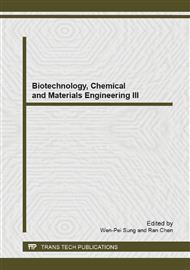p.556
p.560
p.566
p.570
p.574
p.578
p.582
p.586
p.593
Molecular Cloning and Structure Analysis of MpARF, an ADP-Ribosylation Factor in Monascus purpureus
Abstract:
ADP-ribosylation factors (ARF) are ubiquitous regulators of vesicular membrane traffic in all eukaryotic cells. A full-length cDNA encoding an ARF was cloned from the cDNA library of Monascus purpureus. The cDNA was 1275 bp in length, contains a predicted 555 bp ORF that encodes 184 amino acids, the gene was designated MpARF. The deduced amino acid sequence showed high homology to ARF6 of Homo sapiens, ARFB of Aspergillus nidulans and ARF3p of Saccharomyces cerevisiae, including conserved N-terminal myristoylation site, GTP binding and GTP hydrolysis site, suggesting that the MpARF is a member of the ARF6 protein family. A typical G protein fold three-dimensional model of MpARF was built; the structure is similar to the structure of human ARF6. According to the functions of ARFB and ARF3p in fungi, we implicated that the MpARF would involved in hyphal polarized growth.
Info:
Periodical:
Pages:
574-577
Citation:
Online since:
January 2014
Authors:
Price:
Сopyright:
© 2014 Trans Tech Publications Ltd. All Rights Reserved
Share:
Citation:


